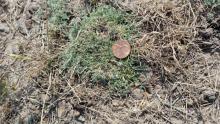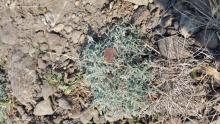i was out doing some seed collecting last week and revisited a population of the nicest form of Lupine i have found. This plant seems to occur in a small area of the Owyhee uplands in Idaho. At first glance it looks like a caespitose Draba from a distance but closer inspection reveals that it is in fact a lupine. These plants have not quite flower yet so i will have to wait several weeks to get seed. Here are a couple of pictures.
Comments
Waht a good eye to spot such
Waht a good eye to spot such tiny wee wonderful things!
There always seems to be something new every time we go walking, doesn't there!
I must say, i have no idea
I must say, i have no idea what this is. It is not Lupinus uncialis which is an annual Lupine. I have tried to key it out but that goes nowhere. I talked to the BLM Botanist a few years ago but she did not know either. i will go out in a couple of weeks and collect some seed, the flowers are the Usual white and blue.
I do like this little lupines
I do like this little lupines and posted a link to this thread in the Scottish Rock Garden Club Forum, where we have also been discussing lupines. A Californian member, who has visited the area in Idaho in the past, wrote this speculative post :
Under satisfactory growing conditions it is possible to casually identify many Lupinus species. Unfortunately growing conditions can vary considerably even at the same site season to season. I have been fooled too many times making a casual identification, so now I always always check completely. To make a positive identification it is necessary to check all parts of the flower and flower bracts or lack of, as well as features of the leaves and the presence or lack of stipules.
I have been in the Owyhee uplands in the past so I will take a wild guess based on the few feature I see in the photographs that it is something like Lupinus lepidus var. aridus. There are other possibilities but this might be a good place to start. Being able to examine a blooming plant will make certain identification possible. If possible I would return when they are blooming.
To the NARGS member - may it be possible for you to return to the site when they are blooming. I would like to know how I did on a long shot guess.





Wow, what a little gem! Any idea as to the species? It sure is a late-bloomer... plants waiting that long to bloom here would not likely have time to set seed!